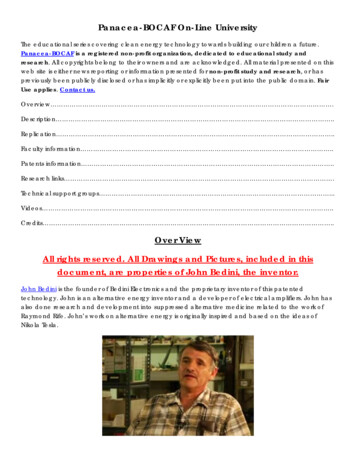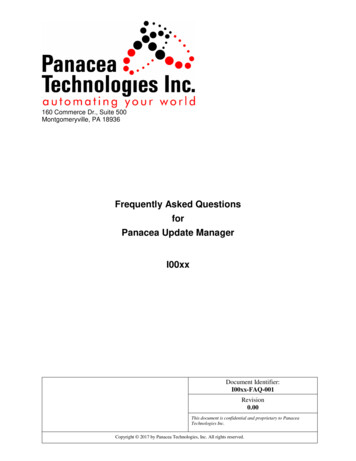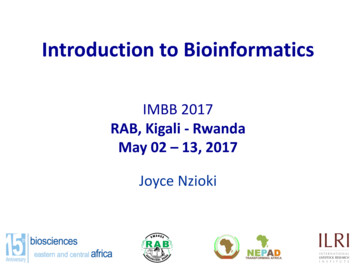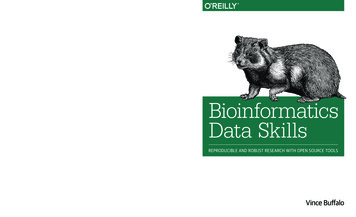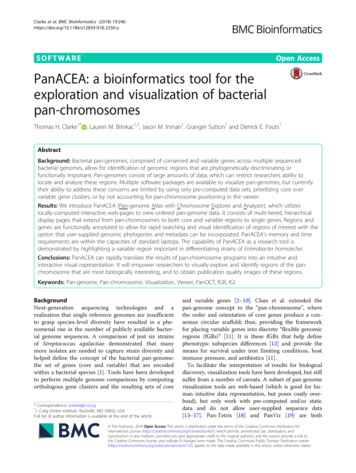
Transcription
Clarke et al. BMC Bioinformatics (2018) TWAREOpen AccessPanACEA: a bioinformatics tool for theexploration and visualization of bacterialpan-chromosomesThomas H. Clarke1* , Lauren M. Brinkac1,2, Jason M. Inman1, Granger Sutton1 and Derrick E. Fouts1AbstractBackground: Bacterial pan-genomes, comprised of conserved and variable genes across multiple sequencedbacterial genomes, allow for identification of genomic regions that are phylogenetically discriminating orfunctionally important. Pan-genomes consist of large amounts of data, which can restrict researchers ability tolocate and analyze these regions. Multiple software packages are available to visualize pan-genomes, but currentlytheir ability to address these concerns are limited by using only pre-computed data sets, prioritizing core overvariable gene clusters, or by not accounting for pan-chromosome positioning in the viewer.Results: We introduce PanACEA (Pan-genome Atlas with Chromosome Explorer and Analyzer), which utilizeslocally-computed interactive web-pages to view ordered pan-genome data. It consists of multi-tiered, hierarchicaldisplay pages that extend from pan-chromosomes to both core and variable regions to single genes. Regions andgenes are functionally annotated to allow for rapid searching and visual identification of regions of interest with theoption that user-supplied genomic phylogenies and metadata can be incorporated. PanACEA’s memory and timerequirements are within the capacities of standard laptops. The capability of PanACEA as a research tool isdemonstrated by highlighting a variable region important in differentiating strains of Enterobacter hormaechei.Conclusions: PanACEA can rapidly translate the results of pan-chromosome programs into an intuitive andinteractive visual representation. It will empower researchers to visually explore and identify regions of the panchromosome that are most biologically interesting, and to obtain publication quality images of these regions.Keywords: Pan-genome, Pan-chromosome, Visualization, Viewer, PanOCT, fGR, fGIBackgroundNext-generation sequencing technologies and arealization that single reference genomes are insufficientto grasp species-level diversity have resulted in a phenomenal rise in the number of publicly available bacterial genome sequences. A comparison of just six strainsof Streptococcus agalactiae demonstrated that manymore isolates are needed to capture strain diversity andhelped define the concept of the bacterial pan-genome:the set of genes (core and variable) that are encodedwithin a bacterial species [1]. Tools have been developedto perform multiple genome comparisons by computingorthologous gene clusters and the resulting sets of core* Correspondence: tclarke@jcvi.org1J. Craig Venter Institute, Rockville, MD 20850, USAFull list of author information is available at the end of the articleand variable genes [2–10]. Chan et al. extended thepan-genome concept to the “pan-chromosome”, wherethe order and orientation of core genes produce a consensus circular scaffold; thus, providing the frameworkfor placing variable genes into discrete “flexible genomicregions (fGRs)” [11]. It is these fGRs that help definephenotypic subspecies differences [12] and provide themeans for survival under iron limiting conditions, hostimmune pressure, and antibiotics [11].To facilitate the interpretation of results for biologicaldiscovery, visualization tools have been developed, but stillsuffer from a number of caveats. A subset of pan-genomevisualization tools are web-based (which is good for human intuitive data representation, but poses costly overhead), but only work with pre-computed and/or staticdata and do not allow user-supplied sequence data[13–17]. Pan-Tetris [18] and PanViz [19] are both The Author(s). 2018 Open Access This article is distributed under the terms of the Creative Commons Attribution 4.0International License (http://creativecommons.org/licenses/by/4.0/), which permits unrestricted use, distribution, andreproduction in any medium, provided you give appropriate credit to the original author(s) and the source, provide a link tothe Creative Commons license, and indicate if changes were made. The Creative Commons Public Domain Dedication o/1.0/) applies to the data made available in this article, unless otherwise stated.
Clarke et al. BMC Bioinformatics (2018) 19:246interactive, but do not easily display variable (a.k.a., flexible) genomic islands (fGIs) [11]. Some visualization toolsfocus on alignments of core regions [20], require complicated database dependencies or produce complicated network diagrams [21]. None of the existing pan-genomevisualization tools are geared toward a standalone (i.e., client side), intuitive, pan-chromosome-based interactivebrowser that will enable researchers to navigate to thoseparts of the pan-genome that are most relevant to understanding strain-specific differences that may impact pathogenesis, antimicrobial resistance, and general fitness in agiven environment.Here we introduce PanACEA (Pan-genome Atlas withChromosome Explorer and Analyzer), an open sourcestandalone computer program written in PERL that generates locally-computed (client side) JavaScript-driveninteractive web-pages to view pan-chromosome datagenerated by PanOCT [4] or other pan-genome clustering tools. It consists of multi-tiered views with circularrepresentations of chromosome(s)/plasmid(s) containingselectable and user-configurable colored functional geneannotations/ontologies and zoomed-in linear illustrations of per genome fGI content in the fGRs locatedthroughout the pan-chromosomes. The program canalso produce views of multiple-sequence alignments ofuser-specified clusters and phylogenetic trees that can becolored based on the presence/absence of user-specifiedregions. Lastly, PanACEA can export publication-quality(SVG) or draft-quality image (PNG) images of any view,text tables, and the nucleotide or protein sequences ofcluster members or representatives. This software wasdeveloped with the goal of being an intuitive,easy-to-use, standalone viewer that will empower researchers with the ability to visualize those regions ofthe pan-chromosome of their choosing that are of mostbiological interest. The identification of these regionsand their surroundings will advance the understandingof the biology of these organisms and how they evolveby proving a much needed tool to comprehend thosegenomic differences that lead to increased antibiotic resistance, pathogen outbreaks, and differences in patientoutcomes.ImplementationPanACEA is written in PERL and utilizes the BioPerlmodule to read in phylogenies. The PanACEA PERLscripts output HTML, JSON, and JavaScript files that areviewable with multiple web browsers, including GoogleChrome (v 63.0), Mozilla Firefox (v 58.0.1), Apple Safari (v11.0.3), and Internet Explorer/Edge (v 11.0.9600.18816/38.14393.1066.0). The scripts also use the MSAViewer[22] to display multiple sequence alignments. All resultingoutput files and functionalities, except for the MSAViewer,can be used offline.Page 2 of 6ResultsData inputPanACEA uses PERL scripts and a tab-delimitedhuman-readable flat file that contains the following necessary information for the script to generateplatform-independent visualizations: the gene order ofthe pan-chromosome “assemblies”, including the flexibleand core regions (such as output of gene order.pl [11]);detailed information about each gene; and the locationof the sequences of the genes. Though this file can berecreated ad hoc and the user manual does provide descriptions, the PanACEA software package includes ascript designed to translate the output of pan-genomesoftware packages to the PanACEA flat file (Fig. 1). Currently, PanACEA must be downloaded or cloned fromthe GitHub site and run locally. As such, the flat file input provides flexibility for the user independent of whichpan-genome generation software they wish to use, bothcurrent and future programs. Currently, PanACEA optimally works with PanOCT [4] and gene order.pl [11]output (both are availible at https://sourceforge.net/projects/panoct/). An example dataset consisting of thePanOCT and gene order.pl derived pangenome of 19Acinetobacter baumannii genomes along with GO termand ARO term based gene annotations is also availableat the PanACEA GitHub repository.Fig. 1 PanACEA Pipeline Flowchart. The PanACEA pipeline with theinitial files shown in dark gray, the PanACEA PERL scripts shown inblue font, the resulting PanACEA intermediate files shown in lightgray, and the final files shown in yellow. The final PanACEA outputincludes all the HTML pages, JSON files, and Javascripts scriptsnecessary to run the viewer. The RGI output referenced is generatedby the RGI software package. Additional information on therequirements for the input files can be found in the user manuallocated on the GitHub page
Clarke et al. BMC Bioinformatics (2018) 19:246Beyond generic input requirements, PanACEA is highlyconfigurable, allowing for customization of input featuresspecific to the needs and available data of the researcher.Additional information, such as that describing the functionality of the genes or the relationship between genomes, can be incorporated (Fig. 1). Any functionalannotation (i.e., Gene Ontology (GO) [23, 24] or Antibiotic Resistance Ontology (ARO) [25] terms) can beadded modularly through a configuration file that will associate colors with functional annotation as well as ontology information. Included with the package are scriptsthat will add annotation to the gene clusters in a formatthat PanACEA can read. For sets of genomes with aknown evolutionary relationship, a Newick-formattedphylogenetic tree file can also be added, along with metadata information about the genomes such as isolationdate, host, serotype, pathogen/non-pathogen, etc.Visualization featuresThe PanACEA interface enables the interactive explorationof pan-genomic data through multiple spatial views, i-gene regions to single gene details (Additional file 1:Figure S1). Pan-scaffold representations can be cyclic or linear and highlight flexible and core regions, with core genesindividually colored by protein function. For cyclic representations, the nucleotide position coordinate system of theconsensus pan-chromosome is used. The pan-scaffolds areshown at identical heights, independent of the number ofgenomes found in each region. For ease of differentiatingshort flexible and core regions, the flexible regions are allshown at staggered instances of three-quarters height, againregardless of how many genomes are contained in that region. Regions of interest, such as those involved in antibiotic resistance, virulence, bacteriophage, plasmid, or anyother user-configured high-level feature can be preferentially displayed. Likewise, the pan-scaffold (main) page contains a table listing regions, genes, and specific functionalterms and can be selected to also highlight the location ofthe genes. The main page includes a text search function tofacilitate identifying specific genes and regions in the tableand a zoom function on the top of the main page. The usercan scale from the pan-scaffold to a more detailed view ofsingle regions, whether a set of core genes or a fGR, eitherby clicking on the region on the pan-scaffold map or in thetable. On separate pages, PanACEA provides a linear representation of gene context, associated functional annotation,and prevalence of the region in each genome. Given thepossible complexity of a fGR, the display can be trimmedto focus on a reduced set of fGIs of interest. Additionally,when included, the genomic phylogeny, accessible from thefGR and core region pages, as well as the gene pages, enables phylogenomic analysis of any region of interest overlaid with user-provided metadata. This functionality can bePage 3 of 6extended to individual gene summary pages, which displaygene annotation and provide access to sequence data andsingle gene analysis tools such as multiple sequence alignments. All PanACEA displays can be exported aspublication-quality SVGs or preview graphics files in otherformats (e.g., PNG) and the gene and region lists in tabulardata as text files.A more detailed description of both the PanACEA software package and the web pages with the visualization,complete with examples and help pages, is available in thePanACEA manual on the GitHub site.Use caseThe biological utility and output of PanACEA is illustrated using the Enterobacter hormaechei pan-genomedata generated from PanOCT from 219 genomes wherePanACEA helped to visualize fGIs responsible for theknown metabolic differences historically used to classifyE. hormaechei subspecies [12]. The time to generate allnecessary files from the PanOCT output to the final webpages was 466 s. In addition to the pan-genome, annotation files for each of the gene clusters calculated usingGO terms and anti-microbial resistance genes from theCARD database using RGI were used [24, 25]. All the E.hormaechei PanACEA files are available on the GitHubsite. The fGR depicted contains two GIs (one flexibleand one core between core gene clusters 3936 and 3949)and encodes metabolic pathways historically used to define phenotypic differences between E. hormaechei subspecies (Fig. 2). E. hormaechei subsp. hormaechei isdistinguishable from E. hormaechei subsp. oharae and E.hormaechei subsp. steigerwaltii by growth on dulcitol(a.k.a. galactitol) as the sole carbon source via the gatoperon [26]. In contrast, E. hormaechei subsp. oharae andsubsp. steigerwaltii both encode a different fGI (the agaoperon) for the metabolism of N-acetylgalactosamine [27](Fig. 2). We readily identified and located the genes andregions of interest by inputting “N-acetylgalactosamine” inthe text search and selecting the highlighted regions andgenes of interest in the main pan-chromosome view asshown in Fig. 2, thus allowing for analysis of the positionalcontext. The output demonstrates the capability of PanACEA to highlight differences between strains in a visuallyinformative manner and present the users withpublication-ready images.DiscussionThe memory and time usage required by the PanACEAscripts to run does not exceed the capabilities of mostlaptops, as shown in Additional file 1: Table S1. Wecompared runs of pan-chromosomes generated from between 20 and 219 genomes. The compute times rangedfrom 80 to 456 s, while the memory usage varied from208 Mb to 3.16 Gb. We further found that increasing
Clarke et al. BMC Bioinformatics (2018) 19:246Page 4 of 6abcFig. 2 PanACEA Views of E. hormaechei gat and aga Operons. The PanACEA pan-chromosome images (a), fGR view (b), and phylogeny (c)showing the gat operon that can differentiate E. hormaechei subsp. hormaechei from other subsp. [12]. The location of the fGI in b and c ishighlighted with the orange box. The default coloring scheme is shown in (a) with variable regions in dark gray and core regions in light gray.The variable regions are also shown at 0.75 height and on alternating sides of the chromosome to help differentiate small neighboring regions.The bounding core region that contains the aga operon is shown in the preview panel highlighted by the light blue box in a. The cluster ofgenomes containing the gat operon fGI are annotated as E and are highlighted in the genome phylogeny in c using the pink box. The images inb and c are derived from PNGs downloaded directly from the website. Additional information about the visualization can be found in the usermanual located on the GitHub pagethe number of fGR paths also lead to an increase inthese requirements - surprisingly somewhat independentof number of genomes. For instance, the 193 E. coli genome pan-chromosome has almost twice as many fGRpaths compared to a 219 E. hormaechei genomepan-chromosome and showed relative increases in timeand memory usage. However, this increase is limited to afew minutes in terms of the CPU and a few gigabytes interms of memory usage.The modularity of PanACEA also allows for morefunctionality to be added. Further possible functions thatcan be included in future versions of PanACEA may include: multiple region views where genomes can becompared across neighboring fG and Core regions; additional gene annotation on the core region images, suchas three letter gene names; graphs and text demonstrating the prevalence of different gene order and geneprevalence in clusters of genomes with the availablemetadata; and finally, to write additional scripts to transform the output from other pan-genome tools such asRoary [6] so that it can be used as input for PanACEA.ConclusionsPanACEA is an interactive visualization tool that leveragesbacterial genomic data for the analysis of pan-genomes inthe context of a consensus pan-chromosome. Its browserinterface displays customizable annotation features suchas the anti-microbial resistance and gene ontologies,which expedite the point-and-click exploration ofpan-chromosomes when compared to text files and previous visualizations that lacked contextual browsing of variable regions. Its hierarchical design enables the navigationof both detailed and high level views of the data. Thesearch and zoom functions permit users to identify genesand regions of interest and view these regions in the context of the full pan-chromosome, zoomed in close, or in
Clarke et al. BMC Bioinformatics (2018) 19:246the detail views in another window, as shown in our usecase. PanACEA is database independent and browser agnostic, easy to install, and works off generalized flat filespromoting interoperability across pan-genome software.Page 5 of 6Author details1J. Craig Venter Institute, Rockville, MD 20850, USA. 2Department ofBiotechnology and Food Technology, Durban University of Technology,Durban 4000, South Africa.Received: 8 September 2017 Accepted: 14 June 2018Availability and requirementsProject name: PanACEA.Project home Operating system(s): Platform independent.Programming language: PERL, HTML, Javascript.Other requirements: PERL v5.22.1, BioPerlv1.007001.License: GNU GPL.Any restrictions to use by non-academics: none.Additional fileAdditinal file 1: Table S1. Memory and CPU time requirement ofmultiple PanACEA runs on a 2.3GHz Linux VM. Figure S1. PanACEAHTML page flowchart. (DOCX 22 kb)AbbreviationsARO: Antibiotic Resistance Ontology; fG: flexible genomic; fGI: flexiblegenomic island; fGR: flexible genome region; GI: Genomic Island; GO: GeneOntology; RGI: Resistance Gene IdentifierAcknowledgementsThe authors would like to thank Chris Greco, Pratap,Venepally, and HarinderSingh for his assistance in software testing and critical review of the helpmanual, and Matthew LaPointe for his suggestions on software and imagegeneration.FundingThis project has been funded in whole or part with federal funds from theNational Institute of Allergy and Infectious Diseases, National Institutes ofHealth, Department of Health and Human Services under Award NumberU19AI110819.Availability of data and materialsAll software and example data sets are available on GitHub at rs’ contributionsDEF conceived the idea behind PanACEA and led the development efforts.THC wrote and debugged all PERL scripts. All authors participated in thedesign and organization of the graphical user interface. GS helped withinterpretation of PanOCT and pan-chromosome (i.e., gene order.pl) outputfiles. JMI provided guidance on code development and standardization andconducted time, memory, and space metrics. LMB led the beta testing efforts. All authors prepared, read and approved the manuscript.Consent for publicationNone declared.Competing interestsThe authors declare that they have no competing interests.Publisher’s NoteSpringer Nature remains neutral with regard to jurisdictional claims inpublished maps and institutional affiliations.References1. Tettelin H, Masignani V, Cieslewicz MJ, Donati C, Medini D, Ward NL, et al.Genome analysis of multiple pathogenic isolates of Streptococcus agalactiae:implications for the microbial pan-genome. Proc Natl Acad Sci U S A. 2005;102:13950–5.2. Remm M, Storm CEV, Sonnhammer ELL. Automatic clustering oforthologs and in-paralogs from pairwise species comparisons. J MolBiol. 2001;314:1041–52.3. Li L, Stoeckert CJ, Roos DS. OrthoMCL: identification of Ortholog groups foreukaryotic genomes. Genome Res. 2003;13:2178–89.4. Fouts DE, Brinkac L, Beck E, Inman J, Sutton G. PanOCT: automatedclustering of orthologs using conserved gene neighborhood for pangenomic analysis of bacterial strains and closely related species. NucleicAcids Res. 2012;40:e172.5. Ozer EA, Allen JP, Hauser AR. Characterization of the core and accessorygenomes of Pseudomonas aeruginosa using bioinformatic tools spine andAGEnt. BMC Genomics. 2014;15:737.6. Page AJ, Cummins CA, Hunt M, Wong VK, Reuter S, Holden MTG, etal. Roary: Rapid large-scale prokaryote pan genome analysis. bioRxiv.2015:019315.7. Contreras-Moreira B, Vinuesa P. GET HOMOLOGUES, a versatile softwarepackage for scalable and robust microbial Pangenome analysis. ApplEnviron Microbiol. 2013;79:7696–701.8. Blom J, Kreis J, Spänig S, Juhre T, Bertelli C, Ernst C, et al. EDGAR 2.0: anenhanced software platform for comparative gene content analyses. NucleicAcids Res. 2016;44:W22–8.9. Chaudhari NM, Gupta VK, Dutta C. BPGA- an ultra-fast pan-genome analysispipeline. Sci Rep. 2016;6:srep24373.10. Zhao Y, Wu J, Yang J, Sun S, Xiao J, Yu J. PGAP: pan-genomes analysispipeline. Bioinformatics. 2012;28:416–8.11. Chan AP, Sutton G, DePew J, Krishnakumar R, Choi Y, Huang X-Z, et al. Anovel method of consensus pan-chromosome assembly and large-scalecomparative analysis reveal the highly flexible pan-genome of Acinetobacterbaumannii. Genome Biol. 2015;16:143.12. Chavda KD, Chen L, Fouts DE, Sutton G, Brinkac L, Jenkins SG, et al.Comprehensive genome analysis of Carbapenemase-producing Enterobacterspp.: new insights into phylogeny, population structure, and resistancemechanisms. MBio. 2016;7:e02093–16.13. Blom J, Albaum SP, Doppmeier D, Pühler A, Vorhölter F-J, Zakrzewski M, etal. EDGAR: a software framework for the comparative analysis of prokaryoticgenomes. BMC Bioinformatics. 2009;10:154.14. Laing C, Buchanan C, Taboada EN, Zhang Y, Kropinski A, Villegas A, etal. Pan-genome sequence analysis using Panseq: an online tool for therapid analysis of core and accessory genomic regions. BMCBioinformatics. 2010;11:461.15. Brittnacher MJ, Fong C, Hayden HS, Jacobs MA, Radey M, Rohmer L.PGAT: a multistrain analysis resource for microbial genomes.Bioinformatics. 2011;27:2429–30.16. Ding W, Baumdicker F, Neher RA pX. pan-genome analysis and exploration.bioRxiv. 2017:072082.17. Pantoja Y, Pinheiro K, Veras A, Araújo F, de SAL, Guimarães LC, et al. PanWeb: aweb interface for pan-genomic analysis. PLoS One. 2017;12:e0178154.18. Hennig A, Bernhardt J, Nieselt K. Pan-Tetris: an interactive visualisation forPan-genomes. BMC Bioinformatics. 2015;16:S3.19. Pedersen TL, Nookaew I, Wayne Ussery D, Månsson M. PanViz:interactive visualization of the structure of functionally annotatedpangenomes. Bioinformatics. 2017;33:1081–2.20. Treangen TJ, Ondov BD, Koren S, Phillippy AM. The harvest suite forrapid core-genome alignment and visualization of thousands ofintraspecific microbial genomes. Genome Biol. 2014;15:524.21. Sheikhizadeh S, Schranz ME, Akdel M, de Ridder D, Smit S. PanTools:representation, storage and exploration of pan-genomic data.Bioinformatics. 2016;32:i487–93.
Clarke et al. BMC Bioinformatics (2018) 19:24622. Yachdav G, Wilzbach S, Rauscher B, Sheridan R, Sillitoe I, Procter J, et al.MSAViewer: interactive JavaScript visualization of multiple sequencealignments. Bioinformatics. 2016;32:3501–3.23. Ashburner M, Ball CA, Blake JA, Botstein D, Butler H, Cherry JM, et al. Geneontology: tool for the unification of biology. The Gene OntologyConsortium Nat Genet. 2000;25:25–9.24. Gene Ontology Consortium. Gene ontology consortium: going forward.Nucleic Acids Res. 2015;43:D1049–56.25. Jia B, Raphenya AR, Alcock B, Waglechner N, Guo P, Tsang KK, et al. CARD2017: expansion and model-centric curation of the comprehensiveantibiotic resistance database. Nucleic Acids Res. 2017;45:D566–73.26. Hoffmann H, Stindl S, Ludwig W, Stumpf A, Mehlen A, Monget D, et al.Enterobacter hormaechei subsp. oharae subsp. nov., E. hormaechei subsp.hormaechei comb. nov., and E. hormaechei subsp. steigerwaltii subsp. nov., threenew subspecies of clinical importance. J Clin Microbiol. 2005;43:3297–303.27. Reizer J, Ramseier TM, Reizer A, Charbit A, Saier MH. Novelphosphotransferase genes revealed by bacterial genome sequencing: agene cluster encoding a putative N-acetylgalactosamine metabolic pathwayin Escherichia coli. Microbiology. 1996;142:231–50.Page 6 of 6
PanACEA's memory and time requirements are within the capacities of standard laptops. The capability of PanACEA as a research tool is demonstrated by highlighting a variable region important in differentiating strains of Enterobacter hormaechei. Conclusions: PanACEA can rapidly translate the results of pan-chromosome programs into an .

